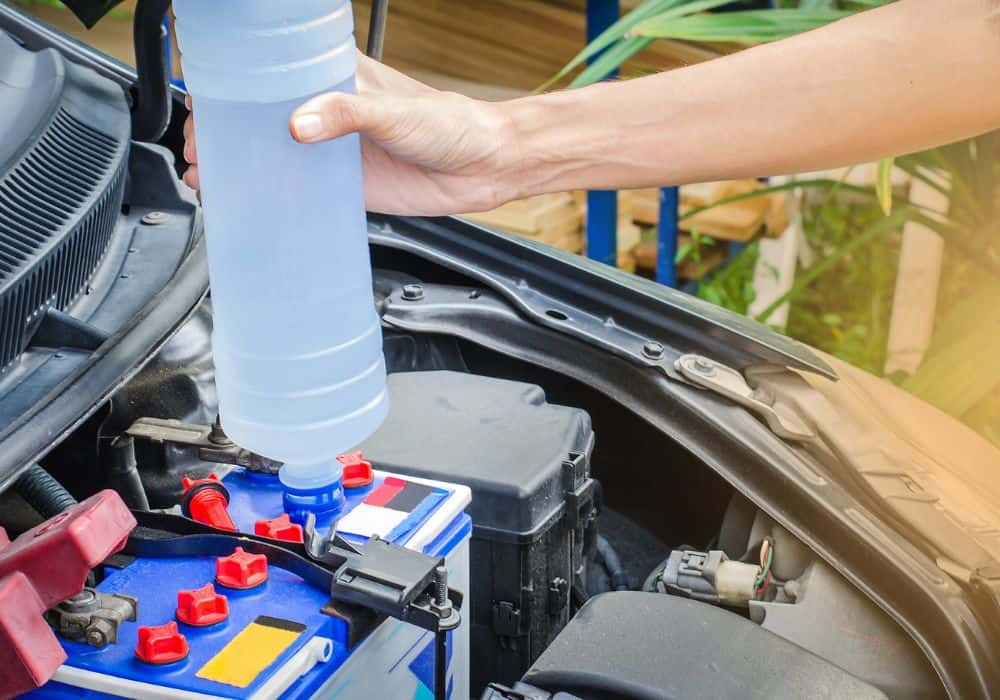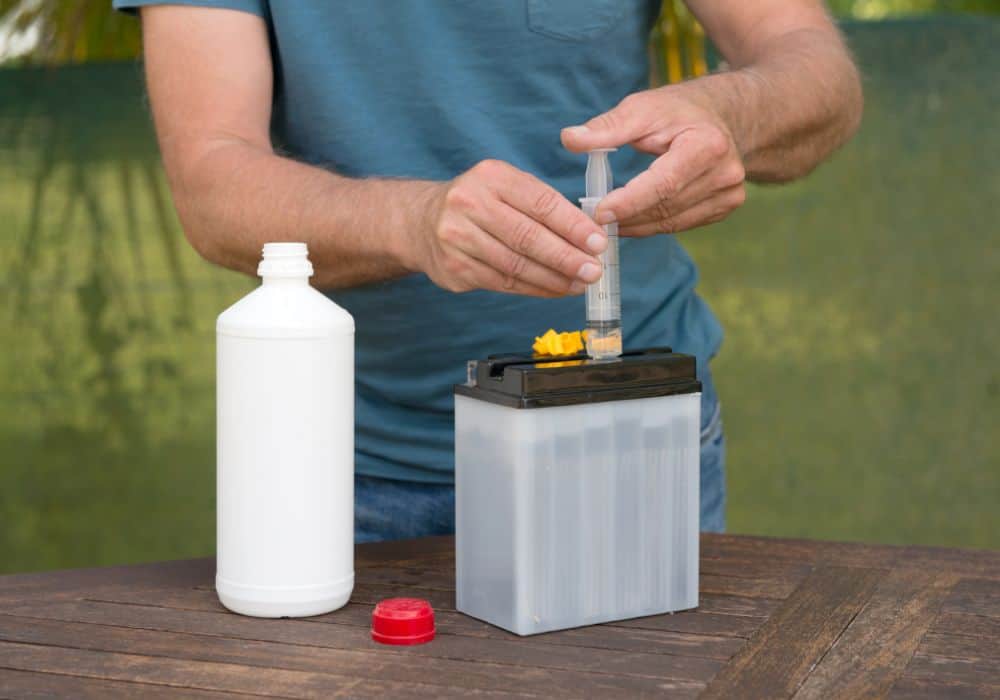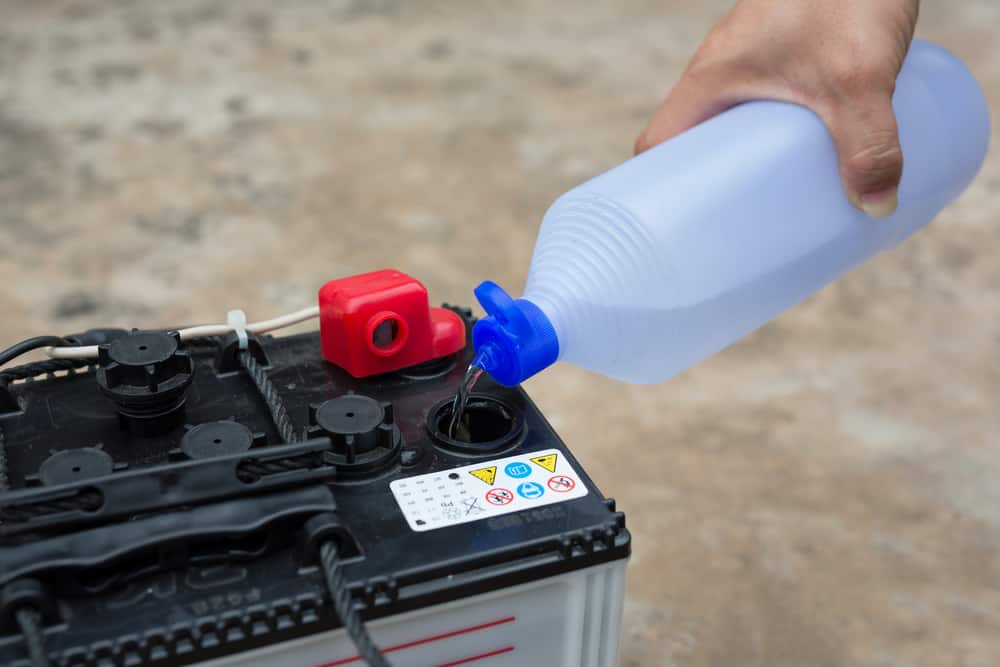Most of the time, water and batteries are a bad mix. The water will damage the electrical components in the battery and you will be left with batteries that do not work. Mixing water and batteries can even be very dangerous. So why would you ever add water to batteries?
That is because there are exceptions to the rule. Lead-acid batteries need water to work properly. But how do you know when to add water to the batteries? And is it better to add water to the battery before or after charging?
In this article, we have covered everything you need to know about adding water to batteries. So read on to learn about the best practice of adding water to batteries.
Table of Contents
What is a Lead-Acid Battery?
Lead-acid batteries are rechargeable batteries and they power the vehicle’s electrical components. The size of a lead-acid battery depends on the number of volts it contains. Their energy density is less than in modern rechargeable batteries.
However, because they are low cost, have a high surge power and have a long shelf life, they are still used in many vehicles that require rechargeable batteries. They are well-suited for powering vehicles such as cars or golf carts that have combustion engines requiring a high current supply to start all electronic components simultaneously.
Lead-Acid Battery Components
Lead-acid batteries have four components which are the positive and negative plate, electrolytes, and a rubber strip. The rubber strip separates the two plates. The positive plate is made of lead peroxide and the negative one of pure lead. While lead peroxide is a hard and brittle material, pure lead is soft and spongy.
The plates are immersed in electrolytes, a combination of water and sulfuric acid. The components are held in place by a plastic case with two plastic leads on top of it. The leads have positive and negative terminals. The case has six chambers with cells that produce 2.1 volts of direct current. When connected, they produce 12.6 volts in total.
Why Do You Need to Add Water To Lead-Acid Batteries?

The electricity from lead-acid batteries is produced through an electrochemical reaction that happens between the electrolytes and the plates. When the battery recharges, electricity flows through the water in the electrolytes. As a result, the water is converted into oxygen and hydrogen gas, the original elements of water.
Over time, as the water is turned back into gasses, the batteries lose water. This is why water needs to be added to the battery to maintain safe functioning. The exception is AGM batteries that can compensate for the loss of water through gassing because of their automatic battery watering technology.
Vented and Sealed Batteries
Whether you need to add water to your battery depends if it is sealed or vented. Sealed batteries do not let the gasses escape and the atoms will reform into water. This process prevents water loss.
Vented batteries will let the gasses out and that will lead to a loss of water inside the battery. This is why adding water is necessary for the proper functioning of the batteries. You should check a vented battery regularly and top up when needed.
Is it Better to Add Water to a Battery Before or After Charging?

It is always best to add water after the battery has been fully charged. This will allow for expansion. Note that you should never add water to the battery when it is hot. Only add water when the battery is cool because the water level is different at different states of charge and needs to be checked at the highest level.
The fluid level is at its highest after expansion when it has been fully charged and then cooled down. If you add water when it is at a lower level, you can add too much. A flooded lead acid battery can result in the water boiling over.
How Do You Know How Much Water You Need to Add?
When you add water to your battery, it is important to add just the right amount to prevent any issues from excess water. You know you have added enough water when the electrolyte level is either a quarter of an inch below the top of the cell or about an eighth of an inch above the plates.
Following these measurements will ensure there is enough space for the expansion of the fluids when the battery is in use or being charged.
What Happens if You Overfill The Battery?
If you overfill the battery, it could overflow or bubble over, spilling the electrolyte solution. This can be dangerous as the solution can cause injury or damage if it comes into contact with other items or your skin. For example, battery acid can corrode the floor of your car or give you painful burns.
Excess water can also dilute the electrolyte solution. When the solution is diluted, it will reduce the battery’s power and lead to poor performance. If too much water is added, it may be necessary to empty some of the electrolytes. This can be a hazardous process, which is why you should speak to a professional.
When Do You Need to Refill Your Battery With Water?
How often you need to top up the water in the battery depends on how often it is used and recharged. A general rule is to add water after five to ten charging cycles. It is not possible to predict the exact moment you will need to add water because that depends on not just the charge cycles but also the size, condition, and age of the battery.
The best way to know when to add water is to check the water level of the battery. Below, we explain how to do this.
Checking the Water Level
To check the level of the water, remove the vent cap or the cell cap on each cell of the battery. If the protective splash plates are covered by the electrolyte solution, you don’t need to add water.
You will need to add water if any splash plates are exposed or the level of the electrolyte is below the splash plate. This video shows you how to check and properly fill your battery with water.
How to Add Water to The Battery?
Give the battery a full charge first and then allow it to cool. Once it has cooled, open the caps on every battery cell. An easy way to add distilled water to your battery is to use a turkey paster. This will ensure water only goes where it is supposed to.
Use the turkey paster to suck up some distilled or deionized water. Squeeze enough water into each battery cell until the metal plate is covered. Replace the caps.
Remember Safety
When adding water to your battery, you must protect yourself from the chemicals in the battery. They can cause painful skin burns if they get into contact with your skin. You need to wear personal protective equipment to prevent injuries.
What you should wear includes protective gloves, goggles or a face shield, and an apron to protect your clothing. If you are working indoors, you also need to ensure there is adequate ventilation in the space.
Can You Use Any Water to Refill Your Battery?
You cannot use just any type of water to refill your lead-acid battery. Only deionized or distilled water should be used for the refilling. You should also check that the pH level of the water is between five and seven. The water should also be within the recommended impurity levels for the battery.
The reason you should only use the above mentioned water is that tap water is not necessarily purified and it can have additional minerals. If you use tap water, you risk upsetting the chemical balance in the battery because the chemicals in the battery will be converted into non-rechargeable ions when they react with the minerals in the water.

What Will Happen if No Water is Added?
If you don’t add water to your battery, you will have reduced battery power which will affect the battery’s performance. Your battery will not charge fully and it will also reduce the lifespan of the battery, meaning you will have a potentially costly battery replacement sooner rather than later.
Conclusion
The best time to charge a battery is after a full charge and when it has cooled down to gauge the battery water levels accurately. For lead-acid batteries, adding water is part of the battery maintenance. Ensuring your battery has enough water, will improve its longevity and ensure the car battery is working at its best capacity.
When refilling the water, you need to be careful to fill the water only up to the correct level. If the battery has too much water, you risk the battery’s electrolyte solution bubbling over and causing damage to your vehicle.
We hope to have covered all your questions about adding water to your car, forklift, or golf cart battery. Should you have other questions about the topic, you can write them in the comments section.
